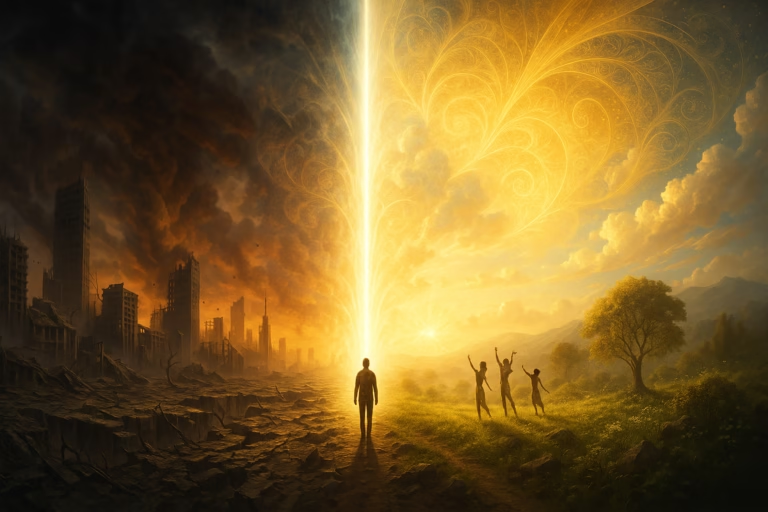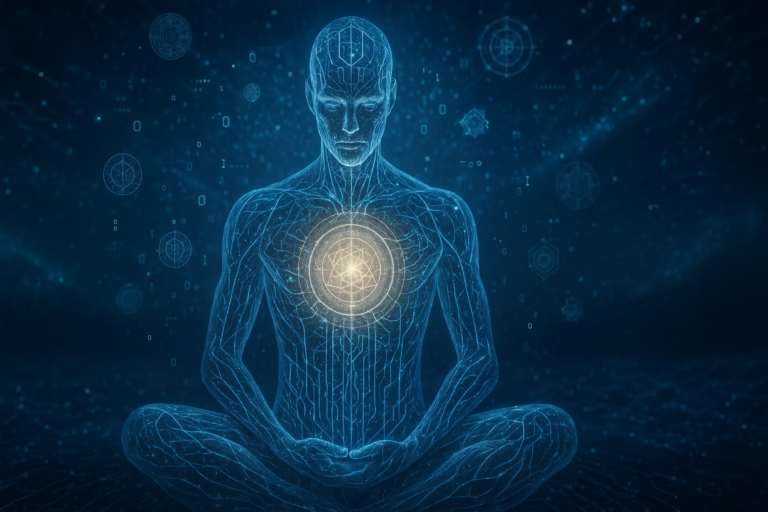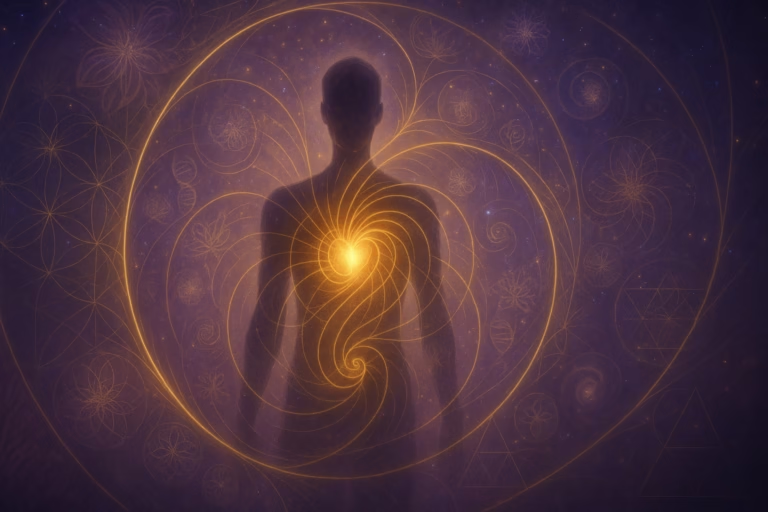PODCAST: Parallel lives
The Lived Paradox: An Introduction to the Split Self
The sensation is fleeting but powerful: a moment in a café, a turn down a street, or a fragment of a conversation that feels simultaneously new and profoundly old. It is an uncanny feeling of having lived this exact moment before, a brief, disorienting “hallucination of familiarity” that defies rational explanation.1 This phenomenon, known as déjà vu, is often dismissed as a minor cognitive misfire, a trivial glitch in the brain’s complex memory system. Yet, for an instant, a deeper, more intuitive part of the mind wonders if it is something more: a fleeting echo from an alternate reality, a memory from a life lived elsewhere.1
The concept of multiple realities is far from new. The term “multiverse” itself, while now ubiquitous in physics, was first coined by the American psychologist William James in 1895, who used it to describe visible nature as a “multiverse” rather than a singular “universe”.3 This etymological origin hints at a deeper, more profound truth: the notion of parallel existence is not merely a modern scientific idea but a recurring human inquiry that spans from ancient philosophical thought experiments to the latest frontiers of quantum mechanics and neuroscience.4 It represents a central paradox of human experience—the rational mind’s insistence on a singular, coherent reality versus our innate, persistent feeling that there might be something more.
This report will explore this paradox by journeying through the landscapes of theoretical physics, cognitive science, and ancient spiritual traditions. It will demonstrate how the concept of a “parallel self” is not just a speculative fantasy but a powerful, universal metaphor for a reality that is far more complex than a singular, linear experience. By examining the scientific arguments for coexisting realities, the psychological mechanisms that create the feeling of being “out of time,” and the spiritual maps of layered existence, a nuanced understanding of identity, destiny, and the unfolding of the self can be achieved.
The Quantum Multiverse: Where Every Choice is Realized
The most compelling modern arguments for coexisting timelines do not come from science fiction but from the deepest and most perplexing theories of physics. At the heart of these theories is a radical new way of interpreting the very nature of reality itself.
The Many-Worlds Interpretation (MWI)
The Many-Worlds Interpretation (MWI) of quantum mechanics, first proposed by physicist Hugh Everett III in 1957 and popularized by Bryce DeWitt, is one of the most intellectually provocative multiverse models.5 MWI was born out of an attempt to resolve a fundamental problem in quantum theory known as the “wave function collapse”.6 The Schrödinger equation describes a quantum system as a superposition of all its possible states, but when an observer measures the system, it appears to “collapse” into a single, definite outcome. MWI offers a solution by asserting that the universal wave function is objectively real and never collapses.5 Instead, every possible outcome of a quantum measurement is physically realized in a different “world” or “branch” of the multiverse.5
This deterministic, local evolution means that at every quantum event—from the decay of a single particle to a seemingly simple human decision—the universe “branches” into an uncountable number of increasingly divergent, non-communicating parallel universes.5 The classic thought experiment of Schrödinger’s Cat provides a perfect illustration. According to the Copenhagen interpretation, the cat is in a superposition of both alive and dead until the box is opened, at which point the wave function collapses to one outcome. In the MWI, both possibilities continue to exist. An observer opening the box splits into two versions: one in a branch where the cat is alive, and one in a different branch where the cat is dead.5 Both outcomes are equally real, and both versions of the observer have an equally valid claim to being the “real” continuation of the original observer.
The Broader Multiverse Framework
It is important to understand that MWI is just one of many theoretical frameworks that propose the existence of a multiverse. Max Tegmark, a cosmologist at MIT, has provided a useful taxonomy by categorizing these disparate ideas into four distinct levels of parallel universes.3 This framework helps to organize the various scientific and philosophical concepts of multiple worlds.
Level of Multiverse | Description |
Level 1 | An extension of our own universe. Due to the infinite nature of space, the laws of probability suggest that there must be another identical copy of Earth somewhere, along with all its inhabitants. 3 |
Level 2 | Other distant regions of space that have different physical constants, even if they operate under the same fundamental laws as our universe. This is a concept that can arise from inflationary cosmology. 3 |
Level 3 | The Many-Worlds Interpretation (MWI), where every possible quantum outcome is realized, leading to a branching, tree-like structure of universes. This is the model where a different version of a person exists for every possible choice they could make. 3 |
Level 4 | Universes that are entirely distinct from our own and may not be connected to ours in any meaningful way. These universes would likely have completely different fundamental physical laws and constants. 3 |
While MWI is a Level 3 multiverse, string theory, which posits a limited number of universes (potentially 11 dimensions), often falls into Level 2 or 4. In these models, a version of a person might exist, but in a world so radically different that their physical makeup has evolved differently, perhaps to breathe water or antimatter.8 This suggests that other universes may not contain carbon copies of ourselves but rather profoundly different iterations of life.
The Philosophical Fallout: Identity and Free Will
The scientific concept of a branching, deterministic multiverse poses profound philosophical challenges, particularly to the concepts of identity and free will. If, as MWI suggests, every choice a person could possibly make is realized by a different version of themselves in a different universe, the very notion of choice can seem meaningless.4 The traditional assumption of free will is that human beings make choices that have genuine consequences in a singular reality. However, if an individual commits an immoral act in one universe while a different version of them refrains from doing so in another, the idea of moral accountability becomes tenuous.4 This challenges existentialist ethics, which, as articulated by Jean-Paul Sartre, places personal responsibility at the foundation of human meaning.4
However, this philosophical critique overlooks a crucial distinction: the difference between a universal, third-person perspective and an individual, first-person one. From a grand cosmic perspective, the outcome of every choice is determined—all possibilities happen in some branch or another.10 But from an individual’s point of view, the question of “which copy you end up as” is fundamentally undetermined.10 The existence of countless versions of oneself in parallel universes does not diminish the reality or consequence of the choices made by the one that a person experiences. The feeling of agency and the struggle to make a decision remain entirely real in the moment. The lived experience of choice, and the responsibility that comes with it, is a first-person phenomenon that is the very substance of our lived reality, regardless of what might be happening in a quantum-entangled branch elsewhere.
The Mind’s Own Multiverse: Psychology and Neuroscience of the Uncanny
Beyond the abstract realms of theoretical physics, the most tangible evidence for “parallel lives” exists within the complex, mysterious landscape of the human brain. Uncanny phenomena like déjà vu, feelings of detachment, and unexplainable knowledge can often be explained by neuroscience and psychology as internal experiences rather than external realities.
Déjà Vu as a Memory Glitch
While it may feel like a glimpse into another timeline, the most widely accepted scientific explanation for déjà vu is that it is a “memory illusion”.11 This sensation is often associated with the temporal lobe of the brain, a region that plays a key role in memory storage and retrieval.1 One prominent theory suggests that déjà vu is caused by a minor processing error in the nervous system.1 For instance, a retrieval cue might trigger a sense of familiarity without retrieving the associated memory itself, leading to the disorienting feeling that an experience is new but a memory from the past.1
Another compelling theory, known as the “perceptual gap” hypothesis, suggests that the brain processes the same sensory signals twice in rapid succession.11 The first processing event is so brief that it goes unnoticed by the conscious mind. When the second, conscious signal arrives almost immediately after, the brain registers it as a familiar event, as if it has already happened.11 These neurological explanations suggest that the human brain, far from being a passive receiver of a singular reality, is an active constructor and editor of our perception. The phenomena we interpret as a glimpse into another world may in fact be momentary failures of our brain’s sophisticated filtering and processing systems. The human tendency to attribute these experiences to a past life or other mystical event highlights the profound gap between the brain’s biological function and our innate desire for a more mystical explanation.1
Derealization and the Detached Self
The sensation of feeling “out of time” or “not fully here” is a core symptom of Depersonalization/Derealization Disorder (DPDR), a complex mental health condition that can make a person feel detached from their body, thoughts, or surroundings.11 This feeling of unreality has a clear neurobiological basis. Studies using fMRI have shown that DPDR is associated with altered activity in brain regions involved in self-awareness and emotional regulation, particularly a hyperactivation of the dorsal anterior cingulate cortex and prefrontal cortex.13 At the same time, there is a reduced activity in the amygdala and insula, which are crucial for processing emotions and bodily sensations.13 This neurochemical imbalance and frontolimbic inhibition can suppress normal emotional responses, creating a sense of emotional numbness and making life feel distant, dreamlike, or unreal.13
The feeling of being “out of time” can also be linked to chronophobia, the extreme fear of time passing.12 This anxiety disorder, which can be triggered by trauma, illness, or a distorted perception of time, can cause a person to feel a constant, overwhelming pressure that time is slipping away.12 These psychological and neuroscientific perspectives indicate that the feelings of detachment and temporal distortion are not evidence of a parallel self but are instead manifestations of the intricate and sometimes fragile relationship between our consciousness and our biology.
The Psychology of “What If” and the Imagined Self
The human mind is a powerful engine of imagination, capable of creating vivid, complex alternate realities. What some might call a “spontaneous memory” from a parallel life can be understood by psychologists as a form of “counterfactual thinking”.15 This is the mind’s natural tendency to construct alternate pasts where events unfolded more perfectly than they did, creating a “parallel, glossier version of your life in your head”.15
While this is a common mental process, dwelling on these idealized versions of the past can be psychologically damaging, leading to regret, rumination, and even depression.15 A person who spends too much time living in this imagined reality may begin to feel that their real life is “unbearably small” and that their goals are pointless in comparison to the cinematic perfection of what “should have been”.15 In this sense, the most real “parallel lives” a person can live are the ones they construct in their own mind. By contrast, a more positive psychological approach involves living spontaneously and embracing uncertainty, which opens doors to new experiences, creative thinking, and a sense of agency that is rooted in the present moment.16
The Spiritual Cosmos: Ancient Maps of Layered Realities
Long before physicists speculated about parallel universes, spiritual and mystical traditions across the world developed rich cosmologies that spoke of layered realities and coexisting planes of existence. These ancient maps of the cosmos offer a powerful, metaphorical framework for understanding the multi-faceted nature of the self.
The Hindu Multiverse of Consciousness
In Hindu cosmology, the universe is believed to be comprised of 14 lokas, or realms, which are divided into seven upper worlds (vyarthis) and seven lower worlds (patalas).17 These realms are not just physical places but also represent different states of consciousness and spiritual awareness within the cycle of samsara (rebirth).18 The concept of the
lokas highlights the interconnectedness of all things and the soul’s journey across different planes of existence, with spiritual progression or regression based on a being’s actions and karma.17
The 14 Lokas of Hinduism | Description |
The Seven Upper Worlds | |
Satya-loka | The highest realm, the abode of Brahma. This is the ultimate destination where the atman (soul) is freed from the cycle of rebirth and attains liberation. 17 |
Tapa-loka | The realm of enlightened beings and ascetics who have dedicated their lives to rigorous spiritual discipline and meditation. 17 |
Jana-loka | The realm of great sages and celestial beings who possess profound knowledge and divine insight. 17 |
Mahar-loka | The dimension of existence for enlightened beings who live in spiritual bliss and are close to ultimate liberation. 17 |
Svar-loka | Indra’s Heaven, a paradise where gods reside and virtuous souls may temporarily dwell before moving to higher spiritual realms. 17 |
Bhuvar-loka | A transitional realm for ancestral spirits (pitris), located between Earth and the Sun, which serves as a place of spiritual purification. 17 |
Bhur-loka | Earth itself, a world where human beings undergo experiences of birth, death, and rebirth in accordance with their karma. 17 |
The Seven Lower Worlds | |
Atala-loka | The first of the lower realms, where beings experience powerful forces that bind them to the material world. 17 |
Vitala-loka | Linked to the energies of transformation and destruction, reflecting the instability of material existence. 17 |
Sutala-loka | The kingdom of the demon king Bali, a realm for powerful beings with moral flaws. 17 |
Talatala-loka | The realm of Maya, where beings are trapped by illusion and attachment to the material world. 17 |
Mahatala-loka | A mysterious and dangerous realm inhabited by serpentine beings. 17 |
Rasatala-loka | The home of demons, where chaos and conflict prevail. 17 |
Patala-loka | The lowest of the patalas, a place of suffering and spiritual darkness, representing the final stage of material entanglement. 17 |
These realms are not just passive locations but are also states of awareness that a person can experience in their nature.18 This suggests that the universe is not just a patchwork of separate worlds but an interconnected system where consciousness itself can move between different planes of existence.
The Buddhist Realms of Rebirth
Buddhist cosmology also describes a system of coexisting realities, typically identifying six realms of rebirth: gods, demi-gods, humans, animals, hungry ghosts, and hells.19 These realms are directly tied to the concept of
karma, where an individual’s actions and intentions determine the realm they will be reborn into.20
Of these six realms, the human realm is considered uniquely fortunate. Unlike the gods, who are so consumed by pleasure that they lack the spiritual impetus for growth, or the beings in the lower realms who are overwhelmed by suffering, humans are capable of experiencing both pain and happiness.20 This balance provides the ideal conditions for a being to pursue enlightenment and ultimately attain
nirvana, the extinction of desire that ends the cycle of rebirth.20 This spiritual framework offers a profound perspective on agency. While modern physics debates whether a person’s choices matter if all outcomes exist in some universe, Buddhist thought emphasizes that in this particular reality, a person has a rare and precious opportunity to transcend suffering through conscious, ethical action. The choices made here and now are not meaningless; they are the very substance of a person’s spiritual liberation.
Shamanic Journeying and Non-Ordinary Realities
Shamanic traditions across the globe have long held a worldview that our ordinary, physical reality is just one of many “non-ordinary” realities that coexist and interweave with what we perceive.21 This is where dreams, visions, intuitions, and the spirits of ancestors and nature reside.21 For thousands of years, shamans have intentionally “journeyed” into these alternate planes to seek knowledge, perform healing, and restore wholeness to their communities.21
This ancient wisdom finds a fascinating echo in modern quantum physics, particularly in the observation that subatomic particles can exist as waves, particles, or a “mysterious cloud of potentiality” until they are observed.22 Both the shamanic and quantum worldviews posit a multi-dimensional reality where consciousness is not a passive spectator but an active participant that influences the fabric of existence.22 The shaman’s work to “dream the world into being” through intention and ritual can be seen as a metaphorical parallel to the quantum observer affecting matter through consciousness.22 This suggests that the search for parallel lives may not be about finding separate, distant worlds but about learning to navigate the layered reality that exists right here, in the interplay between mind and matter.
Weaving the Threads: Synthesizing a Nuanced View
The journey through theoretical physics, cognitive science, and ancient spiritual traditions reveals that the concept of “parallel lives” is a powerful and persistent human idea. Each discipline provides its own unique map of this multi-layered territory, offering different perspectives on a shared mystery. The final step is to synthesize these threads into a cohesive and meaningful narrative.
The Grand Analogy
The physical multiverse, the psychological illusions of the mind, and the spiritual realms of consciousness are all different conceptual maps of the same underlying reality. The notion of “parallel lives” is not so much a literal, testable hypothesis as it is a profound, universal metaphor for a reality that is far more complex than a singular, linear experience.
A compelling bridge between these seemingly disparate fields is the highly speculative “quantum mind” hypothesis, which proposes that quantum phenomena like superposition and entanglement could be at the very root of human consciousness.23 While most scientists remain skeptical due to the warm, chaotic environment of the brain, some studies are exploring whether quantum processes could modulate consciousness.24 This radical idea suggests a potential reversal of the traditional paradigm: what if a person’s brain is not just a flawed processor of a singular reality but a “multiversal” antenna that is mostly out of tune with the other branches of existence?24 This concept, while currently in the realm of science fiction, offers a powerful lens for future inquiry.
The Lived Experience: Case Studies of Unexplainable Memory
While neuroscience provides a compelling explanation for many of the uncanny sensations a person experiences, there are rare and intriguing case studies that challenge the conventional view. Researchers at the University of Virginia’s Division of Perceptual Studies (DOPS), led by the late Dr. Ian Stevenson and continued by Dr. Jim Tucker, have documented over 2500 cases of young children who spontaneously report detailed memories of previous lives.25
One such example is the case of Kumkum Verma, a young girl in India who, at age 3 and a half, began spontaneously speaking of a past life as a blacksmith’s wife in a city 25 miles away.25 Her family, who knew no one from that district, wrote down her detailed statements, which were later verified by researchers. The deceased blacksmith’s family confirmed her descriptions of the city district and provided many other details that matched what she had said.25 Another well-known case is that of James Leininger, who, as a young boy, began having vivid, detailed memories of being a WWII pilot named James Huston Jr., who was shot down in the Pacific.26 Some of these cases are made even more compelling by the presence of birthmarks or birth defects that align with fatal wounds suffered by the deceased individual, as confirmed by postmortem reports.26
While these cases remain a subject of intense scientific debate and skepticism, they stand as powerful data points that challenge the idea of the “self” as a singular, linear event. They suggest that consciousness, or at least memory, may not be confined to a single lifetime.
Identity, Destiny, and the Unfolding Self
The exploration of coexisting timelines reveals a profound conversation between the concepts of destiny and free will. On one hand, MWI suggests a deterministic universe where every possibility happens, but on the other, ancient spiritual traditions offer a framework where ethical choices in the human realm determine a person’s ultimate fate. The psychological view places the power of “shaping reality” in a person’s own mind, for better or worse.
Ultimately, the search for “parallel lives” may not be about finding another universe or another version of oneself. It may be about understanding the profound, layered complexity of a person’s own existence. The true parallel lives may not be “out there” but rather within, a reflection of the infinite possibilities inherent in every moment, every choice, and every unfolding version of the self a person could become. The question remains: how will a person navigate this rich, multi-layered reality to shape the self they are destined to be?
Works cited
- Deja vu | Definition, Facts, & Examples | Britannica, accessed August 17, 2025, https://www.britannica.com/science/deja-vu-psychology
- My Deja vu theory : r/ParallelUniverse – Reddit, accessed August 17, 2025, https://www.reddit.com/r/ParallelUniverse/comments/1ineyxf/my_deja_vu_theory/
- String Theory: Parallel Universes and the Multiverse | dummies, accessed August 17, 2025, https://www.dummies.com/article/academics-the-arts/science/physics/string-theory-parallel-universes-and-the-multiverse-177685/
- The Illusion of Knowledge: A Philosophical and Scientific Critique of Parallel Universes | by Boris (Bruce) Kriger | THE COMMON SENSE WORLD | Medium, accessed August 17, 2025, https://medium.com/common-sense-world/the-illusion-of-knowledge-a-philosophical-and-scientific-critique-of-parallel-universes-34adaa6204a1
- Many-worlds interpretation – Wikipedia, accessed August 17, 2025, https://en.wikipedia.org/wiki/Many-worlds_interpretation
- What’s the difference between Many Worlds Interpretation and Possible Worlds? : r/askphilosophy – Reddit, accessed August 17, 2025, https://www.reddit.com/r/askphilosophy/comments/181w1on/whats_the_difference_between_many_worlds/
- Are Many Worlds and the Multiverse the Same Idea? – Discover Magazine, accessed August 17, 2025, https://www.discovermagazine.com/are-many-worlds-and-the-multiverse-the-same-idea-4965
- The Multiverse, string theory, and how we make choices. – Late Romantic, accessed August 17, 2025, https://lateromantic.com/2021/04/29/the-multiverse-string-theory-and-how-we-make-choices/
- On the Many Worlds Interpretation and Free Will : r/askphilosophy – Reddit, accessed August 17, 2025, https://www.reddit.com/r/askphilosophy/comments/vlxrwk/on_the_many_worlds_interpretation_and_free_will/
- Determinism in Many Worlds : r/freewill – Reddit, accessed August 17, 2025, https://www.reddit.com/r/freewill/comments/1b79fnf/determinism_in_many_worlds/
- What is the science behind déjà vu?, accessed August 17, 2025, https://www.livescience.com/health/psychology/what-is-the-science-behind-deja-vu
- Chronophobia (Fear of Time): Symptoms, Causes & Treatment – Cleveland Clinic, accessed August 17, 2025, https://my.clevelandclinic.org/health/diseases/22579-chronophobia-fear-of-time
- Derealization: Understanding, Diagnosing, and Treatment, accessed August 17, 2025, https://healyournervoussystem.com/derealization-comprehensive-guide-to-understanding-diagnosing-and-treating-the-disorder/
- Why Do I Feel Like I’m Running Out of Time? – Uncover Counseling, accessed August 17, 2025, https://uncovercounseling.com/blog/why-do-i-feel-like-im-running-out-of-time-the-psychology-behind/
- 2 Signs You’re Experiencing the Parallel Life Effect | Psychology …, accessed August 17, 2025, https://www.psychologytoday.com/us/blog/social-instincts/202505/2-signs-youre-experiencing-the-parallel-life-effect
- Overcome Your Fears by Choosing to Live Life More Spontaneously – IQ Matrix Blog, accessed August 17, 2025, https://blog.iqmatrix.com/living-spontaneously
- The Concept of Many Worlds in Hinduism | Revision World, accessed August 17, 2025, https://revisionworld.com/gcse-revision/rs-religious-studies-gcse/hinduism/hindu-beliefs/concept-many-worlds-hinduism
- 14 Lokas Realms:- 7 Upper Worlds (Vyahrtis) & 7 Lower Worlds (Patalas) – Rudraksha Ratna, accessed August 17, 2025, https://www.rudraksha-ratna.com/articles/14-lokas-vyahrtis-and-patalas
- en.wikipedia.org, accessed August 17, 2025, https://en.wikipedia.org/wiki/Sa%E1%B9%83s%C4%81ra_(Buddhism)#:~:text=Buddhist%20cosmology%20typically%20identifies%20six,realm%20constitute%20a%20single%20realm.
- Saṃsāra (Buddhism) – Wikipedia, accessed August 17, 2025, https://en.wikipedia.org/wiki/Sa%E1%B9%83s%C4%81ra_(Buddhism)
- Shamanic journeying: how to get started in 20 minutes | by Zori …, accessed August 17, 2025, https://zoritomova.medium.com/shamanic-journeying-how-to-get-started-in-20-minutes-3f6301a905cd
- Shamanism, Quantum Physics, and Dreaming The World Into Being, accessed August 17, 2025, https://www.shamansmarket.com/blogs/musings/shamanism-quantum-physics-dreaming
- Quantum mind – Wikipedia, accessed August 17, 2025, https://en.wikipedia.org/wiki/Quantum_mind
- Quantum mechanics and the puzzle of human consciousness – Allen Institute, accessed August 17, 2025, https://alleninstitute.org/news/quantum-mechanics-and-the-puzzle-of-human-consciousness/
- Children Who Claim to Remember Previous Lives: Past, Present, and Future ~esearch’ – University of Virginia School of Medicine, accessed August 17, 2025, https://med.virginia.edu/perceptual-studies/wp-content/uploads/sites/360/2015/11/REI35.pdf
- Children Who Report Memories of Past Lives – Division of …, accessed August 17, 2025, https://med.virginia.edu/perceptual-studies/our-research/children-who-report-memories-of-previous-lives/




